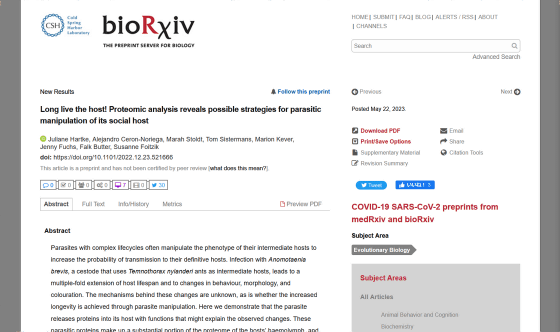How does the ``parasite that extends the lifespan of the host more than several times'' manipulate the lifespan of ants?

by
An ant called Temnothorax nylanderi of the genus Munebosoari that lives in Western Europe quits its job as a worker ant when infected with a parasite called Anomotaenia brevis , a kind of tapeworm, and has a lifespan several times longer than that of other worker ants. known to extend to A German research team has posted a new paper on how such a ``parasite that extends the lifespan of the host'' manipulates the lifespan of ants to bioRxiv, a biological preprint server.
Long live the host! Proteomic analysis reveals possible strategies for parasitic manipulation of its social host | bioRxiv
https://doi.org/10.1101/2022.12.23.521666

There's a Parasite That Triples Ants' Lifespans... And It Actually Sounds Pretty Great : ScienceAlert
https://www.sciencealert.com/there-a-parasite-that-triples-ants-lifespans-and-it-actually-sounds-pretty-great
A tapeworm called Anomotaenia brevis is a parasite whose final host is a woodpecker, and whose intermediate host is an ant that ate woodpecker dung containing tapeworm eggs. Muneboso ants live in a colony with a queen ant at the top, and worker ants take care of the queen ant and finish their lives, but worker ants parasitized by tapeworms quit their jobs and hardly leave the colony. It's going to end.
Not only do the infested ants not work, but they will be taken care of by other workers like a queen ant. A study that continued to observe the colony for three years found that more than half of the tapeworm-infested ants lived for more than three years, whereas other worker ants usually died in a few months. You can read the following article about the research results that ``the life span of ants parasitized by tapeworms is extended''.
What is that strange parasite that there is a ``parasite that extends the life of the host''? -GIGAZINE

A research team led by Susanne Foitzik, a professor of biology at the University of Mainz, Germany, analyzed the hemolymph of ants to investigate the mechanism by which tapeworms extend the lifespan of ants. In mollusks and arthropods with open vasculature that is not closed, there is no distinction between blood, lymph, and interstitial fluid, so these fluids are collectively called hemolymph.
As a result of analysis, it was found that the hemolymph of ants parasitized by tapeworms contains a large amount of ``proteins derived from tapeworms''. Tapeworm-derived proteins contained two antioxidants that may help keep the ants looking youthful, but many of the proteins had unclear roles and types.
In addition, it was found that ants parasitized by tapeworms also have a large amount of a protein called `` vitellogenin-like A '' produced by the ants themselves. Since vitellogenin-like A is involved in the division of labor and reproduction in ant societies, increased amounts of this protein in the infested ant can trick other workers into taking care of them like a queen. The research team believes that
It is unclear whether tapeworms actively manipulate vitellogenin-like A gene expression or whether parasitism induces increased vitellogenin-like A production. ``The caste of social insects is typically controlled by differences in gene expression rather than by genetic differences,'' Foitzik said. It could be a good strategy,' he said.

Related Posts:







